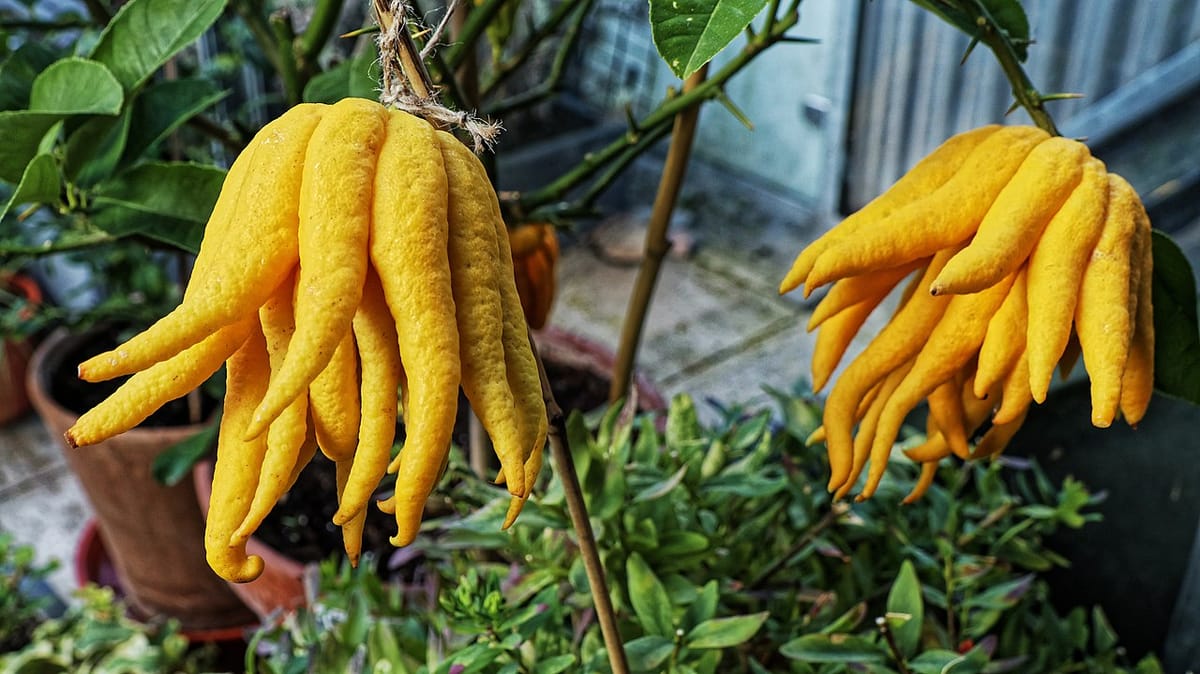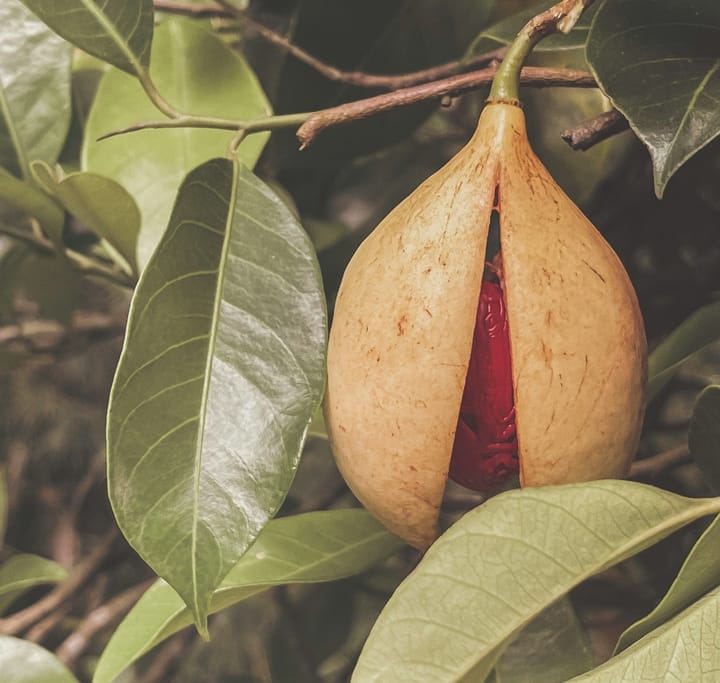Why Is Buddha's Hand Citron So Expensive?
Discover why the ancient Buddha's Hand citron, with its prayer-like shape and fingered segments, comes with such a high price tag.

Buddha's Hand citron, also called the fingered citron, is among the oldest citrus varieties known.
This fruit resembles a lemon with elongated segments that extend outward, forming a shape similar to a hand in a prayer gesture, which is where it gets its name.
The price of a single fingered citron can start at $20 and soar beyond $150, depending on its shape and overall appearance.
So what makes Buddha's Hand citron so costly?
What Is Buddha's Hand Citron?
Buddha's Hand is a distinctive variety of citron, scientifically named Citrus medica var. sarcodactylis. Its name originates from the Greek words sarkos and dactylos, which translate to "fleshy finger."
As a member of the citron family, one of the oldest citrus varieties, Buddha's Hand is notable for its unique structure.
Unlike typical citrus fruits, it consists of elongated, finger-like segments that spread outward, resembling a hand in a gesture of blessing or prayer—hence its name.
When ripe, the fruit is usually a vibrant yellow and can vary in size. However, it stands out from other citrus fruits due to its minimal to non-existent pulp or juice.
The "fingers" of Buddha's Hand are actually carpels that have separated into fleshless segments.
These segments can take on various forms: they may be tightly clustered, creating a shape akin to a hand in prayer, or they might fan out, reminiscent of a squid in motion or the relaxed arms of an octopus.
Why Is it So Expensive?
Buddha's Hand Citron is notably expensive due to several factors rooted in its cultivation challenges and cultural significance.
- Sensitive Cultivation: Buddha's Hand trees are highly sensitive, with delicate roots that are easily damaged. If the trees suffer significant harm, they cannot be replanted, often forcing farmers to relocate their operations to new farms. This risk means that farmers may go several years without profit if things go wrong.
- Labor-Intensive Harvesting: The harvesting process is exceptionally manual and labor-intensive. Farmers can only harvest a few fruits from each tree at a time, and the process must be done with care to preserve the fruit's quality. After harvesting, the trees need to be replanted in new soil to maintain their health, adding to the overall cost.
- Long Maturation Period: Buddha's Hand trees take up to 10 years to begin bearing fruit, compared to lemon trees that can start producing within 6 to 12 months. This long maturation period ties up resources and increases the financial risk for farmers, contributing to the fruit's high price.
- Vietnamese Festival Demand: The timing and quality of Buddha's Hand fruit are crucial, especially during Vietnamese festivals where the fruit is in high demand. Farmers are under pressure to produce large, fleshy fruits on time, which adds to the expense as it requires meticulous care and precise timing.
- Shape Variability and Pruning: The most desirable Buddha's Hand fruits have evenly short fingers with a large base, which are more fragrant and longer-lasting. However, the shape of the fruit is largely uncontrollable, with some seasons producing longer fingers and others shorter. Farmers also need to regularly prune the trees to encourage growth, further increasing labor and costs.
- Insect Threats: The biggest challenge in growing perfect Buddha's Hand Citron is the threat from insects, especially when the trees are in bloom. The most serious pest is the Asian citrus psyllid, which can devastate citrus crops, even spreading as far as the US. If detected early, farmers may lose 5-10% of their crop, but if not controlled, the damage can be total. Additionally, aphids can leave unsightly black spots on the fruit, further diminishing its value.
- Fragile Nature of the Fruit: After harvesting, Buddha's Hand requires careful packaging due to its delicate structure. The fruit’s "fingers" are prone to breaking off, so farmers take special precautions by wrapping them in shredded paper to prevent damage. Proper packaging is essential to maintain the fruit's freshness for up to three months, which is crucial for its marketability.
- High Demand from Chefs and Artisans: The fruit is highly sought after by pastry chefs and liquor makers, particularly in its dried form, for its intense fragrance and unique flavor. This demand, coupled with the labor-intensive cultivation and handling processes, further drives up the price.
How Perfecting Buddha's Hand Citron Shape Increases Its Price
Reaching the perfection of Buddha's Hand Citron shape refers to cultivating the fruit to achieve its most desirable and aesthetically pleasing form. This ideal shape is characterized by several key features:
- Symmetry: The "fingers" of the Buddha's Hand should be well-formed, evenly spaced, and symmetrical. The balance and harmony of the fingers contribute to the overall beauty of the fruit.
- Length and Curvature: The fingers should be long, gracefully curved, and proportionate, resembling a hand in a prayer gesture. A perfect Buddha's Hand typically has fingers that are neither too short nor too elongated, with a natural curvature that enhances its visual appeal.
- Compactness or Spread: Depending on cultural preferences or specific uses, the fingers may be tightly grouped together, resembling a closed hand in prayer, or more spread out like an open hand. Both forms are valued, but the uniformity and smoothness of the segments are crucial.
- Color and Texture: The skin of a perfect Buddha's Hand should be a vibrant, uniform yellow without blemishes, spots, or wrinkles. The texture should be smooth, with a glossy appearance that indicates freshness.
- Fragrance: While shape is the primary focus, the fruit's aromatic quality is also essential. A perfect Buddha's Hand has a strong, pleasant citrus fragrance, which is a significant factor in its overall desirability.
Taste and Flavor Profile of Buddha's Hand Citrus
Buddha's Hand Citron is known more for its aroma and zest than its taste, as the fruit typically lacks pulp and juice. The flavor profile can be described as follows:
Aroma: Buddha's Hand has an incredibly intense and fragrant aroma, often described as a blend of lemon and floral notes. The scent is bright, citrusy, and slightly sweet, making it highly prized in both culinary and perfumery applications.
Zest: The zest of Buddha's Hand is the most commonly used part of the fruit. It has a vibrant lemon-like flavor with a hint of sweetness and a mild bitterness. The zest is more aromatic and less acidic than that of a typical lemon, making it ideal for infusing flavors into dishes, desserts, and spirits.
Bitterness: While Buddha's Hand is not eaten like a typical fruit due to its lack of flesh, the pith (the white part beneath the rind) is not as bitter as in other citrus fruits. This makes it easier to use in its entirety, especially for candied preparations.
Buddha's Hand Citron in Symbolic Culture Around the World
Vietnam Tet Festival (Lunar New Year): In Vietnam, Buddha's Hand citrus is an essential part of Tet, the Vietnamese Lunar New Year celebration. The fruit is placed on family altars as an offering to ancestors, symbolizing prayers for prosperity, happiness, and protection in the coming year. Its unique shape, resembling a hand in a gesture of prayer or blessing, is believed to bring good fortune and peace to the household.
China: In China, Buddha's Hand is similarly valued for its symbolic meaning. It is often used in religious offerings and is associated with happiness, longevity, and prosperity. The fruit is commonly placed on altars in temples and homes to invoke blessings and ward off negative energy. It is also a popular gift during Chinese New Year, representing well wishes and good luck for the recipient.
Japan: In Japan, Buddha's Hand is known as "Bushukan" and is used in religious and cultural practices. The fruit is offered at Buddhist temples, symbolizing the Buddha's open hand and the offering of protection and blessings. It is also used as a natural air freshener due to its strong, pleasant fragrance and is sometimes displayed in homes as a symbol of good fortune.
India: In India, where the fruit is believed to have originated, Buddha's Hand is used in Hindu rituals and offerings. The fruit's spiritual significance is tied to its resemblance to a hand, which is seen as an auspicious symbol in many cultures. It is also used in traditional medicine for its aromatic properties.
Culinary Uses of Buddha's Hand Citron
Buddha's Hand citron is primarily utilized for its zest and aromatic qualities rather than for eating as a traditional fruit. Here are some of its common culinary applications:
- Zest and Flavoring: The zest of Buddha's Hand is the most versatile part of the fruit. It can be finely grated and used to add a bright, lemony flavor to a wide range of dishes, including salads, sauces, dressings, and marinades. The zest is also used to flavor baked goods like cakes, cookies, and pastries, providing a fragrant, citrusy note without the acidity of lemon juice.
- Candied Buddha's Hand: One of the most popular ways to use Buddha's Hand is by candying the peel. The fruit is sliced into segments, boiled, and then simmered in sugar syrup until translucent. Candied Buddha's Hand can be eaten as a sweet treat, used as a garnish for desserts, or added to fruitcakes and confections for a burst of citrus flavor.
- Infusions and Syrups: The fruit is often used to infuse spirits like vodka, gin, or rum, imparting its unique citrus fragrance to the alcohol. It can also be used to make citrus-flavored syrups, which are ideal for cocktails, mocktails, and desserts.
- Tea and Tisanes: Buddha's Hand zest can be dried and used to flavor teas and herbal infusions. The zest adds a subtle, fragrant citrus flavor that pairs well with green tea, black tea, or herbal blends.
- Culinary Aromatics: Due to its strong fragrance, Buddha's Hand is sometimes used as an aromatic ingredient in cooking, particularly in Asian cuisine. It can be added to broths, soups, or stews for a delicate citrus flavor, or used to perfume rice and grain dishes.
- Garnishing: The striking appearance of Buddha's Hand makes it an attractive garnish for a variety of dishes. Its zest can be used to decorate plates, or the fruit itself can be displayed as a centerpiece, adding both visual appeal and a pleasant fragrance to the dining experience.
Overall, Buddha's Hand Citron is a prized ingredient for its ability to add a subtle, aromatic citrus flavor to dishes without overpowering other flavors. Its unique fragrance and versatility make it a favorite among chefs and culinary enthusiasts.


